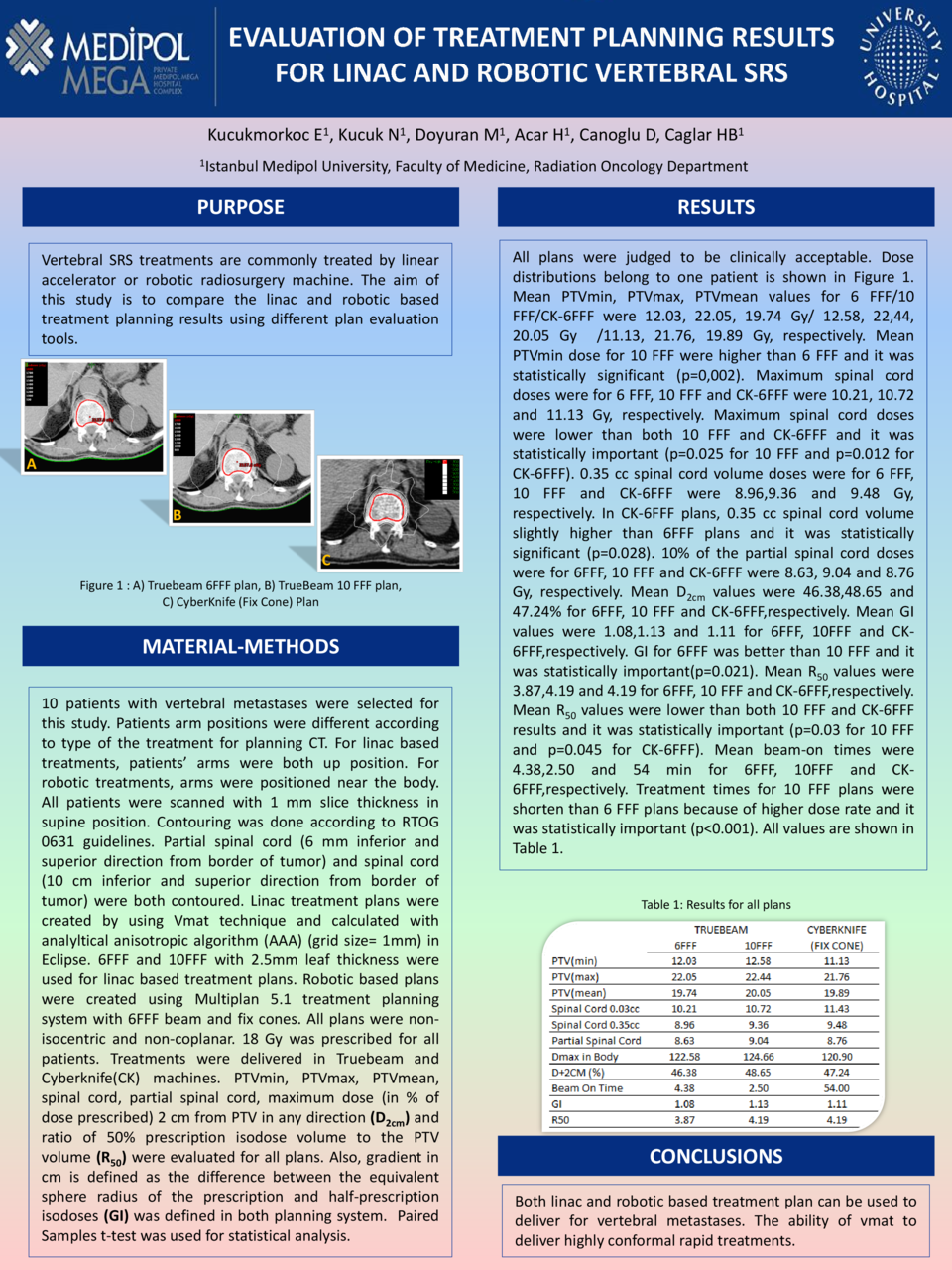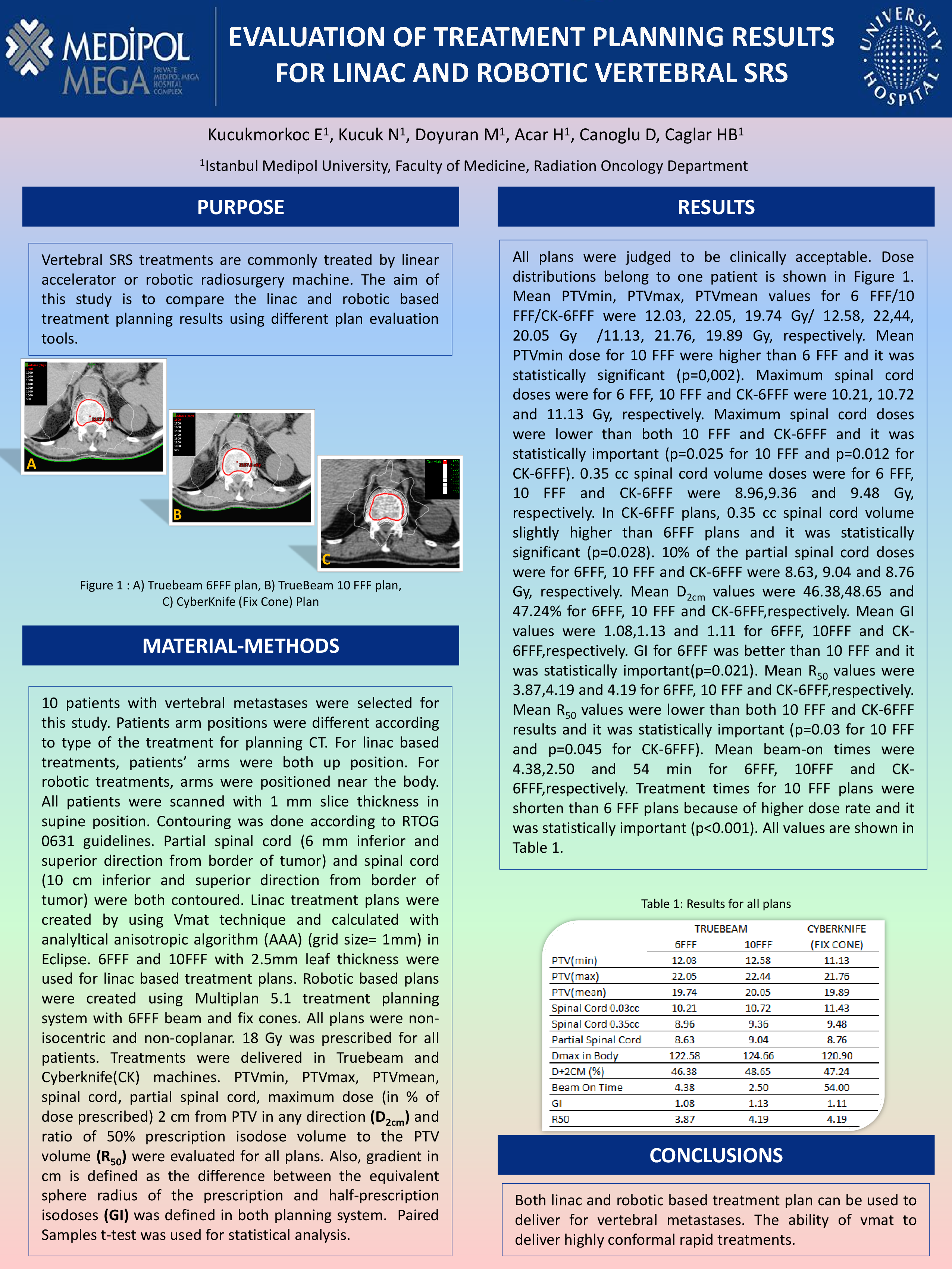Abstract
Purpose: Vertebral SRS treatments are commonly treated by linear accelerator or robotic radiosurgery machine. The aim of this study is to compare the linac and robotic based treatment planning results using different plan evaluation tools.
Material and Method: 10 patients with vertebral metastases were selected for this study. Patients arm positions were different according to type of the treatment for planning CT. For linac based treatments, patients’ arms were both up position. For robotic treatments, arms were positioned near the body. All patients were scanned with 1 mm slice thickness in supine position. Contouring was done according to RTOG 0631 guidelines. Partial spinal cord (6 mm inferior and superior direction from border of tumor) and spinal cord (10 cm inferior and superior direction from border of tumor) were both contoured. Linac treatment plans were created by using Vmat technique and calculated with analyltical anisotropic algorithm (AAA) (grid size= 1mm) in Eclipse. 6FFF and 10FFF with 2.5mm leaf thickness were used for linac based treatment plans. Robotic based plans were created using Multiplan 5.1 treatment planning system with 6FFF beam and fix cones. All plans were non-isocentric and non-coplanar. 18 Gy was prescribed for all patients. Treatments were delivered in Truebeam and Cyberknife(CK) machines. PTVmin, PTVmax, PTVmean, spinal cord, partial spinal cord, maximum dose (in % of dose prescribed) 2 cm from PTV in any direction (D2cm) and ratio of 50% prescription isodose volume to the PTV volume (R50) were evaluated for all plans. Also, gradient in cm is defined as the difference between the equivalent sphere radius of the prescription and half-prescription isodoses (GI) was defined in both planning system. Paired Samples t-test was used for statistical analysis.
Result: All plans were judged to be clinically acceptable. Mean PTVmin, PTVmax, PTVmean values for 6 FFF/10 FFF/CK-6FFF were 12.03,22.05,19.74 Gy/12.58,22,44,20.05 Gy /11.13,21.76,19.89 Gy, respectively. Mean PTVmin dose for 10 FFF were higher than 6 FFF and it was statistically significant (p=0,002). Maximum spinal cord doses were for 6 FFF, 10 FFF and CK-6FFF were 10.21, 10.72 and 11.13 Gy, respectively. Maximum spinal cord doses were lower than both 10 FFF and CK-6FFF and it was statistically important (p=0.025 for 10 FFF and p=0.012 for CK-6FFF). 0.35 cc spinal cord volume doses were for 6 FFF, 10 FFF and CK-6FFF were 8.96,9.36 and 9.48 Gy, respectively. In CK-6FFF plans, 0.35 cc spinal cord volume slightly higher than 6FFF plans and it was statistically significant (p=0.028). 10% of the partial spinal cord doses were for 6FFF, 10 FFF and CK-6FFF were 8.63, 9.04 and 8.76 Gy, respectively. Mean D2cm values were 46.38,48.65 and 47.24% for 6FFF, 10 FFF and CK-6FFF,respectively. Mean GI values were 1.08,1.13 and 1.11 for 6FFF, 10FFF and CK-6FFF,respectively. GI for 6FFF was better than 10 FFF and it was statistically important(p=0.021). Mean R50 values were 3.87,4.19 and 4.19 for 6FFF, 10 FFF and CK-6FFF,respectively. Mean R50 values were lower than both 10 FFF and CK-6FFF results and it was statistically important (p=0.03 for 10 FFF and p=0.045 for CK-6FFF). Mean beam-on times were 4.38,2.50 and 54 min for 6FFF, 10FFF and CK-6FFF,respectively. Treatment times for 10 FFF plans were shorten than 6 FFF plans because of higher dose rate and it was statistically important (p˂0.001).
CONCLUSION: Both linac and robotic based treatment plan can be used to deliver for vertebral metastases. The ability of vmat to deliver highly conformal rapid treatments.





